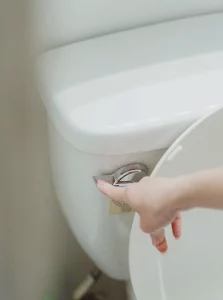
Nowadays a toilet is not a luxury – it is a necessity. Unfortunately, as lovely as it is to have a toilet at home, it is common to experience all kinds of issues with it. When there is a problem with the toilet, it is of crucial importance to determine what is causing the problem and address it as soon as possible. Clogged toilets are typically blamed on someone who placed too much toilet paper in the toilet bowl before flushing.
Toilets can develop drain clogs for a variety of causes, most of which include partial or complete obstruction in one of the drain system’s numerous components: the toilet trap, the branch drain line, the vent pipe, or the main sewer line. The most simple solution for a blocked toilet is to simply plunge the toilet bowl; however, if a toilet clogs regularly, even with an acceptable amount of toilet paper and waste, there may be a larger problem to fix.
Keep reading to find out what the most common causes of clogged toilets are and how to quickly resolve any issues.
- Flushing wipes, paper towels, and other items that do not belong in the drain.
It’s a common misperception that certain goods can be safely flushed down the toilet. Wipes, for example, even those labelled as flushable wipes, cause substantial problems in the domestic plumbing system, and they are a major issue in the larger municipal sewage system. Paper towels are another product that appears to be flushable, but most paper towel types are designed to resist tearing even when totally saturated. Because of their physical resistance, they are difficult to break down and travel through the drain pipe. Disposable cloths, menstrual products, napkins, ear swabs, and hair are some of the most popular items flushed down the toilet, but it’s vital to remember that the toilet is not a garbage can. It is not meant to handle these substances, and flushing them frequently can result in clogs in the toilet or further down the line, causing persistent problems for the entire plumbing system.To fix those: You can always plunge the toilet or use a toilet bowl snake. However, if this is the issue, you may need to speak to the members of your household. If they don’t change their habits, the clogging will keep occurring. Place rubbish bins in every bathroom and make sure everyone is using them.
- A blocked toilet trap.
The toilet outlet enters a curved channel inside the porcelain base of the toilet. It is designed to contain standing water and prevent odorous sewer gases from leaking through the toilet bowl into the house. This is the feature that maintains a tiny quantity of standing water in the bowl after each flush. This S- or P-shaped part of the porcelain bowl links the toilet to the drain pipes in the residence. In most situations, the built-in trap of the toilet base can be identified by looking at it from the side, where the outlines of the trap can be seen. The most common cause of toilet clogs is a blockage in the curved part of the porcelain toilet base. When too much debris is forced through the toilet bowl, the trap section frequently becomes clogged. When the toilet trap is just partially blocked, the toilet will still flush, but the water will drain slower than usual. However, as any homeowner will discover, if the toilet bowl overflows fully, pouring wastewater down onto the bathroom floor, partial clogs have most likely progressed to complete jams.
To fix this issue: You can also use a plunger or a toilet bowl snake to push through the clogging matter or simply help break it apart.
Sewer line issues
The primary sewer line that exits the home either runs underground to a municipal sewer system or to a septic tank. The sewer line is relatively well-protected against rain, sleet, snow, and freezing due to its underground location; however, it is sensitive to tree roots, which can wrap around or puncture the pipe. When the main sewage line is ruptured or crushed, the exit to the septic tank or municipal sewer system becomes constrained, causing toilets and other plumbing fixtures to drain slowly or not at all. Furthermore, rocks, dirt, and other debris can enter the line through the punctures, causing additional drainage issues. It is easy to determine if that is the cause of clogging since it will affect more than one bathroom/drain.
How to fix: Depending on the severity of the case, and the exact reason, you may need to take different approaches. In general, it is best to call a professional company to take care of it. If there are branches puncturing your pipelines, they will easily clear them and repair the issue. For such cases, we suggest you don’t attempt anything on your own since you may actually make the issue worse and cause a lot more trouble.
